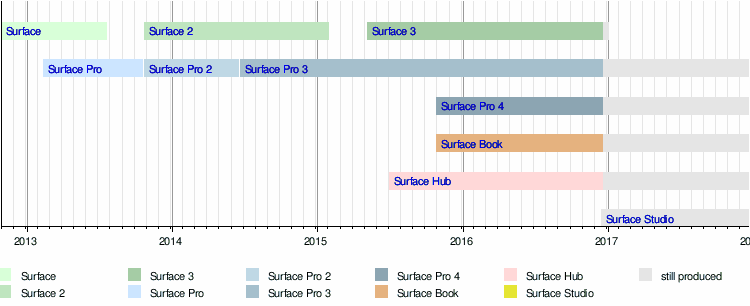Surface Pro 4
 | |
| Developer | Microsoft |
|---|---|
| Product family | Surface |
| Type | 2-in-1 detachable |
| Generation | 4th |
| Release date | October 26, 2015[1] |
| Introductory price | $899 (£749) |
| Operating system | Windows 10 Pro |
| CPU |
Intel Skylake low-voltage dual-core:[2] m3-6Y30 900 MHz up to 2.2 GHz, 4 MB cache, 4.5 W[3] i5-6300U 2.4 up to 3.0 GHz, 3 MB cache, 15 W[4] i7-6650U 2.2 up to 3.4 GHz, 4 MB cache, 15 W[5] |
| Memory | 4 GB, 8 GB, or 16 GB[6] |
| Storage | PCI-Express SSD: 128 GB, 256 GB, 512 GB, or 1 TB[6] |
| Display | 12.3 inches (31 cm) 2736x1824 (267ppi) Pixel Sense display with 3:2 aspect ratio[6] |
| Graphics |
m3: Intel HD graphics 515[6] |
| Dimensions |
292.1 millimetres (11.50 in) (width) 201.42 millimetres (7.930 in) (height) 8.45 millimetres (0.333 in) (depth)[6] |
| Weight |
m3: 766 grams (1.689 lb)[6] |
| Predecessor | Surface Pro 3 |
| This article is part of a series on the |
| Microsoft Surface |
|---|
The Surface Pro 4 is the fourth-generation Surface-series 2-in-1 detachable, designed, developed, marketed, and produced by Microsoft. The Surface Pro 4 was announced on October 6, 2015[7] alongside the Surface Book. In the U.S. and Canada, the Surface Pro 4 was released on October 26, 2015.
The Surface Pro 4 is an update over its predecessor, featuring more power-efficient and powerful CPUs, more capacious RAM and SSD options, a slightly bigger display with a greater resolution, and a better cooled chassis. At the same time, the device is compatible with most of its predecessor's accessories.
History
The Surface Pro 4 was announced on October 6, 2015 alongside the Surface Book. Both devices were available for a pre-order the following day and available for customers beginning on October 26, 2015.
The device initially exhibited failure to sleep properly, which drained the battery very quickly.[8] Microsoft subsequently developed a fix that was made available on February 17, 2016.[9]
Features
Hardware
The Surface Pro 4 is the same size as the Surface Pro 3, but has a thinner screen bezel which allows for a display of a slightly greater size of 12.3 inches (31 cm). The screen resolution is also greater than the Surface Pro 3's, at 2736x1824 at 267 PPI, with the same aspect ratio of 3:2 and 10-point multi-touch. The chassis is 0.03 inches (0.76 mm) thinner and 0.03 pounds (14 g) lighter than the Surface Pro 3.
The cooling system of the 2-in-1 has been redesigned and dubbed hybrid liquid cooling system. It includes heat pipes with a flowing liquid, which help avoid the use of the internal fan when the device is used for non-demanding tasks such as web browsing.
All Surface Pro 4 models feature 6th generation Skylake Intel Core processors: m3, i5 or i7, which are more powerful and run cooler over its Intel Core Haswell predecessors found in the Surface Pro 3 and 2. The maximum clock rate of the most powerful CPU option (i7-6650U) is also greater at 2.2 GHz, with up to 3.4 GHz in the Turbo Boost mode. The m3-powered model is completely fanless.
System memory and SSD options available are 4, 8, 16 GB and 128, 256, 512, 1024 GB respectively; the top options are two times as capacious compared to top options of the Surface Pro 4's two recent predecessors.
The common traits, inherited from the previous generation device, are a continuous kickstand, magnesium casing with a silver-colored back side, 802.11a/b/g/n/ac Wi-Fi radio, Bluetooth 4.0 Low Energy, full-size USB 3.0 port, microSD card reader, headset jack, Mini DisplayPort, Cover Port, and a renamed SurfaceConnect, a port on the side to connect a wall charger, Docking Station or Surface Dock accessories.
| Surface Pro 4 Configuration Options[10] | ||||
|---|---|---|---|---|
| Price Tier (USD) | CPU | Integrated GPU | RAM | Internal Storage |
| 899 | Intel Core m3-6Y30 (0.9 to 2.2 GHz) | HD 515 | 4 GB | 128 GB |
| 999 | Intel Core i5-6300U (2.4 to 3.0 GHz) | HD 520 | ||
| 1299 | 8 GB | 256 GB | ||
| 1499 | 16 GB | |||
| 1699 | 8 GB | 512 GB | ||
| 1899 | 16 GB | |||
| 1599 | Intel Core i7-6650U (2.2 to 3.4 GHz) | Iris 540 | 8 GB | 256 GB |
| 1799 | 16 GB | |||
| 2199 | 512 GB | |||
| 2699 | 1 TB | |||
Software
All Surface Pro 4 models come with a 64-bit version of Windows 10 Pro and a Microsoft Office 30-day trial. Windows 10 comes pre-installed with Mail, Calendar, People, Xbox (app), Photos, Movies and TV, Groove, and Microsoft Edge. With Windows 10 the Tablet mode is available when the Type Cover is detached from the device. In this mode, all windows are opened full-screen and the interface becomes more touch-centric.
The device also has a Windows Hello-compatible camera. It combines the use of a regular and infrared cameras to authenticate the user.
Accessories
The Surface Pro 4 is backward compatible with all accessories of its predecessor. At the Windows 10 Devices Event on 6 October, 2015, alongside new Surface 2-in-1s, new accessories were announced.
The Surface Dock is a redesigned docking accessory in a brick form factor. It is compatible with all past and future Surface models with a SurfaceConnect side port, previously used to connect a wall charger or Docking Station accessory: Surface Pro 3, 4 and Surface Book. The Surface Dock will have 2 Mini DisplayPorts, 1 Gigabit Ethernet, 4 USB 3.0, and 1 audio out ports.
Although Surface Pro 4 is backward compatible with Type Cover accessory of Surface Pro 3, an attachable keyboard, which doubles as a screen protector, the Surface Pro 4 Type Cover has been announced with and without a fingerprint ID sensor. The new Type Cover is thinner and lighter than its predecessor, has improved magnetic stability for lap use, a mechanical keyboard with improved key spacing, as well as a larger touchpad.
An updated version of Surface Pen is included with the Surface Pro 4, which has 1024 levels of pressure sensitivity and is heavier with a rubberized tip.[11] There is a new rubber-like eraser that doubles as a button, which may perform different tasks, like opening the OneNote app or activating Cortana.[12] The Surface app allows users to change what action is performed when the button is pressed.[13]
Reception
Reception
The Surface Pro 4 received generally positive reviews from technology critics. Most praise a sharper and larger display compared to the one found in the predecessor, redesigned cooling system, improved technical specifications, and an improved Type Cover. The common disadvantages found by reviewers were that the Type Cover is still a separate purchase, the relatively modest performance of the Intel Core m3 chip, and modest battery life.[14][15][16]
Timeline

Source: Microsoft Devices Blog
References
- ↑ "Microsoft Surface Pro 4 announced with new Surface Pen, starts at $899". The Verge.
- ↑ "Here are the details of the Surface Book and Surface Pro 4 chips, and why they matter".
- ↑ "ARK Intel Core m3 Specifications".
- ↑ "ARK Intel Core i5 Specifications".
- ↑ "ARK Intel Core i7 Specifications".
- 1 2 3 4 5 6 7 8 9 10 "Surface Pro 4 – Power Through Your Day". October 6, 2015.
- ↑ Microsoft Unveils the Surface Pro 4 With a 12.3-inch Display
- ↑ Surface Pro 4, Surface Book 'sleep' fix coming soon (early 2016)
- ↑ Microsoft Patches Surface Book And Surface Pro 4 Sleep Issue
- ↑ "Surface Pro 4 tablet models". November 5, 2015.
- ↑ Heslip, Ken (6 October 2015). "Microsoft's new Surface Pen now available for pre-order". WinBeta.
- ↑ Guim, Mark (22 October 2015). "3 essential shortcuts you should know for the new Surface Pen". Windows Central.
- ↑ Coppock, Mark (16 December 2015). "You can now customize the Surface Pen buttons on your Surface Book and Surface Pro". WinBeta.
- ↑ Devindra, Hardawar (21 November 2015). "Surface Pro 4 review: Yes, it can really replace your laptop". Engadget.com. Retrieved 13 November 2015.
- ↑ Davies, Chris (21 October 2015). "Surface Pro 4 Review". SlashGear.com. Retrieved 13 November 2015.
- ↑ Osborne, Joe (8 November 2015). "Microsoft Surface Pro 4 review". TechRadar.com. Retrieved 17 November 2015.
| Preceded by Surface Pro 3 |
Surface Pro 4 4th generation |
Succeeded by Latest Model |
.svg.png)
